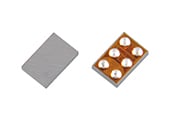Toshiba Electronic Devices & Storage Corporation Releases 1.5A LDO Regulators in Industry’s Smallest Package for Mobile Applications
November 15, 2017
Toshiba Electronic Devices & Storage Corporation

TOKYO— Toshiba Electronic Devices & Storage Corporation has today started shipping “TCR15AG,” a low-dropout (LDO) regulator series in the industry’s smallest[1] WCSP6F package. The TCR15AG series is suitable for mobile and modular applications requiring small, thin devices.
Despite its small package, the TCR15AG series can drive a high current of 1.5A, suiting it for power supply applications in Wi-Fi® chipsets for smartphones and tablets, cameras and wireless modules. The new series can also control power supply in applications requiring a high current, including notebook PCs, digital camcorders, storage devices and set-top boxes.
TCR15AG series deliver the industry’s best-in-class[1] ripple rejection ratio and load transient response. They significantly reduce the ripple noise from a power management IC (PMIC) or a DC-DC converter that is often a limiting factor in the power supply for cameras and radio-frequency (RF) circuits. This helps to minimize output voltage fluctuations that occur in response to sharp changes in current during mode transitions in cameras and RF circuits.
Low voltage dropout is secured by use of an external bias voltage pin (VBIAS), which helps to improve system power efficiency and contributes to longer charge life for the batteries of mobile products.
The series offers two kinds of output voltage—adjustable output between 0.60V and 3.6V via external resistors, and fixed output voltages from 0.65 V to 3.6 V—enabling support for a wide range of power supply applications.
The TCR15AG series extensive protection features include overcurrent protection and thermal shutdown, positioning it as a high-efficiency LDO solution for applications requiring highly regulated voltage in the high-current region and low power consumption.
Applications
- Smartphones, tablets, notebook PC, digital video cameras, storage equipment, set-top boxes
Features
- High output current of 1.5 A in the industry’s smallest WCSP6F package
- The industry’s highest ripple rejection ratio and fastest load transient response; highly suited to camera and RF applications
- Low dropout voltage, a requirement for high-efficiency power supply applications
- Protection features include overcurrent protection, thermal shutdown, inrush current reduction and auto-discharge.
(@Ta=25℃)
| Items | TCR15AG series Fixed Output Voltage |
Adjustable Output Voltage |
||
|---|---|---|---|---|
| Package | Name | WCSP6F | ||
| Dimension typ.(mm) | 1.2×0.8, t:0.33 (max) | |||
| Operating Range | Output current IOUT(A) |
1.5 | ||
Bias voltage |
VOUT <= 1.1 V, IOUT = 1 mA | 2.5 (min) , 5.5 (max) | ||
VOUT > 1.1 V, IOUT = 1 mA |
VOUT +1.4 (min) , 5.5 (max) | |||
Output voltage VOUT(V) |
0.65 to 3.6 | 0.60 to 3.6 | ||
Input voltage VIN(V)@IOUT=0 mA |
VOUT + VDO (min), VBIAS (max) | |||
Electrical Characteristics |
Bias current IB typ.(μA)@IOUT=0 mA [2] | 25 | ||
Ripple rejection ratio R.R.(VIN) typ.(dB) [3] |
95 | |||
Drop-out voltage VDO typ.(mV)@VBIAS=3.3 V, IOUT=1.5 A [4] |
120 | |||
Load transient response ⊿VOUT typ.(mV) @IOUT=10 mA⇔1.5 A |
-100,+115 | |||
Line-up
| Product No. | VOUT(V)(typ.) |
Product No. | VOUT(V)(typ.) |
|---|---|---|---|
| 0.65 | 2.1 | ||
| 0.7 | 2.2 | ||
| 0.75 | 2.3 | ||
| 0.8 | 2.4 | ||
| 0.85 | 2.5 | ||
| 0.9 | 2.6 | ||
| 0.95 | 2.7 | ||
| 1.0 | 2.75 | ||
| 1.05 | 2.8 | ||
| 1.1 | 2.85 | ||
| 1.15 | 2.9 | ||
| 1.2 | 2.95 | ||
| 1.25 | 3.0 | ||
| 1.3 | 3.05 | ||
| 1.35 | 3.1 | ||
| 1.4 | 3.2 | ||
| 1.5 | 3.25 | ||
| 1.6 | 3.3 | ||
| 1.7 | 3.35 | ||
| 1.75 | 3.4 | ||
| 1.8 | 3.5 | ||
| 1.85 | 3.6 | ||
| 1.9 | Adjustable | ||
| 2.0 |
Notes:
[1]: As of November 15, 2017 for LDO regulator ICs with an output current of 1.5A. Toshiba Electronic Devices & Storage Corporation survey.
[2]: Not including a control terminal current (Icr) and a current flowing through an external resistor for a variable-output LDO regulator
[3]: VBIAS = 3.3V, VIN = VOUT + 1V, IOUT = 10mA, VOUT = 0.9V, f = 1kHz, VIN Ripple = 200 mVp-p, Ta = 25°C, COUT = 4.7μF
[4]: Measured at 0.9V output with the TCR15AGADJ variable-output LDO regulator. VDO = VIN1*1 - (VOUT1*2 – 100 mV)
*1: VIN1 is an input voltage when the output voltage drops from VOUT1 to 100 mV.
*2: VOUT1 is an output voltage when VN = VOUT + 0.5 V.
* Wi-Fi is a registered trademark of Wi-Fi Alliance.
Follow the link below for more on Toshiba Electronic Devices & Storage Corporation’s LDO Regulator line-up.
Customer Inquiries:
Small Signal Device Sales & Marketing Department
Tel: +81-3-3457-3411
Information in this document, including product prices and specifications, content of services and contact information, is current on the date of the announcement but is subject to change without prior notice.